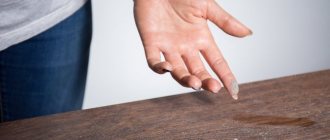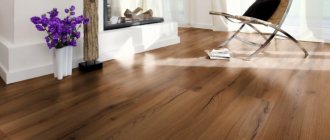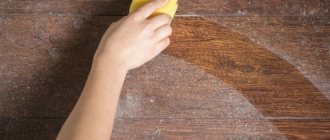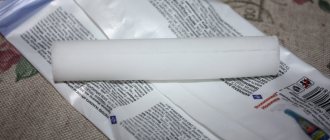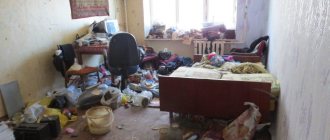In the home of even the cleanest housewife, dust forms from time to time. It is impossible to get rid of it completely. After all, even in a house where no one lives, after a while a large gray layer appears. To find out why and where dust comes from in an apartment, you first need to understand what its composition is.
Dust is small solid particles ranging in size from 0.01 to 10 microns. It is divided into small and large. The big one is the one that annoys us. It accumulates in corners and under the sofa, and lies in a layer on shelves and furniture. However, the greatest danger comes from fine dust, which we, in principle, do not see. A large amount of it is found in polluted air. Penetrating into our body, it damages the walls of blood vessels and is harmful to health.
Where does dust come from?
Oddly enough, the reason for the appearance of dust in the home is the person himself. After all, it is formed because particles of dead skin epithelium enter the air.
House dust also includes micro particles from the street, such as sand, smoke, and pollen. Everything that can penetrate into the apartment along with street air.
Which product to choose for dust removal
Hardware stores provide a large selection of formulations that will help combat small particles. They prevent the accumulation of dust on surfaces, but do not eliminate regular wet cleaning, and will help optimize the process and make it simpler and more efficient.
Polishes
Apply to cleaned wood surfaces coated with varnish or paint. The compositions prevent dust particles from accumulating on the horizontal surfaces of cabinets and facades and give the shine characteristic of well-kept furniture.
Antistatic agents
Remove static electricity from household appliances, which attracts dust like a magnet. The use of the product will prevent clogging of cracks with small particles, which will simplify the cleaning process.
Sprays
Aerosol formulations are convenient for routine wiping of surfaces without water. It is enough to apply the spray on the cabinet, mirror or floor lamp and wipe with a soft cloth. The product effectively copes with the accumulation of dust, destroys dust mites and mold spores.
Impregnations
They are used to care for the upholstery of sofas, armchairs, ottomans and other upholstered furniture in the home. The product does not damage the fabric and creates a protective barrier for the accumulation of dust inside the structure.
If there is no special composition in the house that is necessary to protect surfaces, try using traditional methods. Given the insufficient development of the chemical industry during the time of our grandmothers and mothers, they successfully used the available means.
Rose or lavender oil
Due to their natural properties, they are excellent antistatic agents that will protect surfaces from dust accumulation. It is enough to add a few drops of oil to the water when cleaning and the house will not only shine with cleanliness, but also smell with a pleasant aroma.
Fabric softener
An excellent and safe antistatic agent for all surfaces. To clean, you need to dilute 20 ml of the product in a liter of water and moisten a rag in this solution when cleaning. Conditioner is also recommended for adding when washing walls and ceilings.
Glycerol
The product solution is suitable for cleaning polished surfaces of cabinets and wooden elements of upholstered furniture. To prepare the product, you need to dilute pharmaceutical glycerin in water 1:10 and safely get rid of dust.
Alcohol
It can not only quickly get rid of accumulated dirt, but also disinfect surfaces. The alcohol solution quickly evaporates from fabrics and can be safely used to wipe leather sofas and armchairs, as well as other soft upholstery. It will perfectly clean mirrors, glass and is safe for varnished surfaces. To prepare the solution, you need to dilute vodka with water 1:1 or add 20 ml of alcohol to a glass of liquid.
For washing, it is recommended to use soft, well-wrung fabrics. Cotton, microfiber and wool are suitable; they will do an excellent job of collecting dust and will not leave streaks on the surface.
How dust affects health
First of all, it is necessary to remember that wet dust collection is important not so much for the aesthetic beauty of the apartment, but rather for the health of the people living in it. Breathing in dust every day can irritate the lungs and airways and lead to complications in lung diseases.
Dust is a habitat for bacteria, fungi and dust mites. Mites, in turn, can provoke severe allergies. Which can subsequently lead to asthma.
That is why it is necessary to pay due attention to cleaning the apartment; this is necessary for the well-being of all household members.
Household chemicals
When cleaning, you need to use household chemicals that reduce the ability of objects to accumulate static electricity. Microparticles, as a rule, have a certain microscopic charge of their own and are attracted to a surface that is oppositely charged. Antistatic treatment prevents particles from settling on the treated surface.
You can use any glass cleaner that does not contain alcohol. It perfectly cleans all surfaces from plastic panels, computers, wooden furniture to tiled walls. However, special products are even better suited for wooden surfaces.
Special disposable napkins have proven themselves well in everyday life. They are produced both universal and special: for plastic, wood, screens and glass, etc. Those sold in car dealerships and intended for car care are especially good.
How to get rid of dust in an apartment
Of course, you won’t be able to get rid of dust once and for all, but you can significantly reduce its presence in the apartment. To do this, there is a list of simple rules that will help in resolving this issue.
Wet cleaning
In order to significantly reduce the presence of dust in the apartment, it is recommended to carry out wet cleaning as often as possible.
- It is most practical to use a special microfiber cloth for cleaning; it catches small particles of dust better.
- It is necessary to remember that cleaning should be done wet; using a dry cloth will simply scatter a large amount of dust throughout the apartment.
Regular washing and cleaning
An apartment without dust is the desire of, perhaps, every housewife. To do this, you need to keep the house clean. Change bed linen regularly to fresh ones. If you have carpets, vacuum them several times a day. Go through tulle curtains and other textiles with a steam cleaner.
Pet care
A lot of dust in the apartment is generated by four-legged friends. You can reduce its amount if you constantly wash your pet’s paws after walking outside. It is also necessary to comb the animal as often as possible, and it is best to do this in the bathroom or outside.
Cleaning up excess clutter
How to deal with dust in an apartment if it is cluttered? In fact, it is necessary to sort through things that have not been used for a long time, put them in boxes or throw them away.
Unneeded books, notebooks, figurines and souvenirs are all favorite places for large amounts of dust to accumulate.
Modern technologies
Progress does not stand still, and today you can purchase useful equipment that will clear the air of dust. These are humidifiers, air washers and air purifiers. You can choose an option for a family with any budget. At the moment, all this equipment pleases with quite reasonable prices.
Correctly selected detergents
The best dust remover should have an antistatic effect. This will help to significantly reduce its formation on the surface of the furniture.
Biological objects
More than half the volume of dust consists of tiny particles of dead epidermis and hair. Naturally, their number increases significantly if there are animals at home - dogs, cats, rabbits, birds. True, pet lovers usually treat this issue rather uncritically, taking the fight against dirt as a given. Offer to remove pets from their lives - and they are more likely to agree that fighting dust is not such an evil thing. But it is better to abandon pillows and blankets filled with wool, feathers, down, and cotton wool in favor of synthetic materials. They don't produce as many particles and are much easier to clean.
If a person regularly goes to a good bathhouse, uses hard washcloths and scrubs, fewer epidermal particles enter the surrounding space from his body. To reduce the amount of such elements of animal origin, you also need to take good care of your pets, regularly brush their fur, comb it, and it will be easier to fight for cleanliness.
Why can there be more dust in winter? When the air humidity in the apartment is low, the hair and upper layers of the skin become dry and flake more. Use humidifiers to restore optimal humidity. Humidity should be 55-60%, but usually these indicators are kept at 25-30%. Increase the air humidity in the house - and getting rid of the problem of rapid pollution of the apartment will become a little easier.
Microscopically small dust mites quickly multiply in biological residues. Their waste becomes an additional source of tiny particles. People prone to allergies react to them. And that’s why it’s worth starting to fight it even before the first attacks of allergic cough begin. It is unlikely that it will be possible to completely clean an apartment of dust mites, but it is quite possible to significantly reduce its colonies.
Video about the causes of the problem
Another source of biological dust and allergens is mold and fungal spores. You may not even notice how mold appears in the bathroom or toilet, at the joint between tiles or in a dark nook. But these invisible parasites release millions of spores into the air, which scatter throughout the house. This is why it is so important to maintain normal humidity and temperature in all rooms.
Time-tested people's advice
Modern housewives know many ways and means of getting rid of dust in the apartment:
Cleaning from top to bottom
This is necessary to prevent dust from falling onto the cleaned surfaces from above. Always start dusting from the top.
Closed window
Ventilating the apartment several times a day is necessary, but you should not forget that you should not keep the windows open all the time, since a large amount of dust enters the apartment with the street air.
It should also be remembered that mosquito nets on the windows are an excellent assistant for the modern housewife; they can protect the apartment from the entry of more dust.
- Covers for storing clothes. They are essential for storing things you rarely use. These are seasonal clothes, blankets, pillows, blankets and other small items.
- Alcohol solution. All light bulbs in the apartment must be treated with a cloth moistened with an alcohol solution. This will help dust settle on them in much smaller quantities.
- Cleaning the vacuum cleaner and hood. It is necessary to ensure the cleanliness of the vacuum cleaner filters. Since a dirty filter contributes to the release of a large amount of dust into the air of the apartment. You should not forget to clean the grills on the hood in the kitchen and bathroom at least once every two weeks. It is on them that a huge amount of dust accumulates.
- Fight the carpets. Carpets are real dust collectors in homes. They need to be vacuumed several times a day. It's better not to buy them at all. If carpets are necessary, then it is better to purchase them from natural material. After all, synthetics attract dust.
- Caring for indoor plants. Houseplants help purify the air in your apartment. In order for them to cope better with their function, keep the leaves of the plants and the pots in which they grow clean.
Fabric softener
There will be less dust in the apartment thanks to a solution prepared from fabric softener. Dust will accumulate less on treated surfaces.
- To prepare it, you need to take a spray bottle, fill it with 150 milliliters of clean water and 50 milliliters of any fabric softener.
- Spray the prepared solution onto the surfaces needed for treatment and wipe dry with a cloth.
Cleaning roller for clothes
Thanks to its sticky structure, it will help remove dust from fabric surfaces and lampshades. This will significantly reduce cleaning time.
Cosmetic brushes
In order to remove dust from small objects and in hard-to-reach places, you need to use a cosmetic brush. The natural pile of which will perfectly attract dust particles.
By following these simple rules, there will be much less dust in the apartment, the air will become cleaner and the mood of the household will improve significantly.
About vacuum cleaners and other equipment
The best vacuum cleaners have a water filter. The least effective ones are those with fabric garbage bags. From such models, up to 1/3 of the collected dust is returned into the space during operation. Washing models often raise humidity above normal levels, which can lead to mold. They are best used for cleaning smooth floors made of linoleum, tiles or stone.
A great invention is robotic vacuum cleaners. If there are shaggy pets in the house, these modest workers will not live long, but in a house without animals they are very effective. Turn on the robot and it rolls around on the floor, sucking up crumbs, hair, threads and other dirt. You can get rid of most of the dirt that has settled on the floor without any effort. The fight for cleanliness becomes just fun.
An expensive but effective thing is an air purifier. True, it needs to be moved from place to place all the time - the range of action is small, only about a meter. And the purifier can only handle one room. But it really allows you to quite effectively get rid of microparticles flying around the room.
You can use a humidifier that works on the “cold steam” principle for cleaning. It is also often called an “air washer.” This device also needs to be rearranged. The advantages are the restoration of normal humidity in the house and, if desired, aromatization.
The ionizer is able to slightly reduce the amount of dust in the air. Under its influence, the particles become heavier and settle. They become easier to remove.
Photos of the best anti-dust products in the apartment
BOOK
Book dust is a product of paper breakdown. It is “produced” not only by old books, but also by paper wallpaper, as well as boxes and other things made from cellulose. There is a lot of this in attics, in basements where paper archives are stored, in libraries (including home ones, where books are on open shelves), as well as in general in old apartments that have not been renovated for a long time. Unfortunately, the vacuum cleaner copes poorly with such dust. The dust that is formed when erasing paper easily penetrates the human respiratory tract. Therefore, it is quite allergenic. Plus contains various impurities due to paints, as well as mold particles.
What to do about it: keep books in closed cabinets and separate rooms - definitely not in the bedroom or in the nursery.
STATIC
This is any dust, or rather, a classic home mix of different types of dust with particles of anything - from animal excrement to dust mites, which is electrified by household appliances. Static dust is an increased risk of lung diseases, since it constantly hangs in the air and those present are forced to breathe it.
What to do about it: there are antistatic products (wipes, cleaning solutions, etc.) that fight charged dust. Air washing also helps.
GYPSUM
Many people don’t even know about the existence of such dust. Nevertheless, it is quite possible to encounter it in an ordinary apartment - in particular, where there are plasterboard decorative elements: partitions, arches, pseudo-columns, etc. Drywall generates quite a lot of dust, thereby increasing the load on the residents’ bodies, causing irritation of the respiratory tract.
What to do about it: do not skimp on materials for repairs, do them more often (ecologists generally say that there is less dust where repairs are carried out regularly), and during work use protective equipment such as glasses and masks. The rest of the time - wet cleaning.
Provoking factors for dust accumulation
Dust is present on all surfaces in the house, but there are places and objects where it lingers better, but is less easily removed. Interestingly, in a standard three-room apartment, up to 40 kg can accumulate in a year. The best dust collectors are:
- carpet floor coverings;
- carpets and rugs, both synthetic and natural wool;
- children's soft toys;
- curtains and curtains made of dense heavy materials, especially covered with pile, for example, velvet or velor;
- clothes laid out outside closets and chests of drawers, old rags, printed materials;
- various household equipment that perfectly attracts dust particles due to static electricity.
The dustiest places in the apartment are the back surface of the refrigerator and the floor spaces under large furniture (wardrobes, sofas).
Sources and composition of dust
Dust is a finely dispersed suspension that is constantly present in the air. It is found in all corners of the earth, and air masses carry it over vast distances. The common dust that covers the furniture in our apartments contains sand from various deserts, volcanic ash, evaporating mineral particles that were once part of sea water, and even elements from distant stars.
The most active sources of dust on earth are deserts. In addition, the winds blow away tiny parts of any type of soil and carry them far from their home. The largest dust particles come to us from volcanoes, where there is a lot of ash from previous eruptions. Another component of dust is the combustion products of oil, peat, coal, and also those released into the air during large fires. Cosmic dust also settles on Earth, brought with it by comets and asteroids flying close to our planet.
The source of dust is both humans and domestic animals. The smallest horny particles of skin are constantly exfoliated from the body and join the air mass. Plants also contribute to the community by producing pollen when they bloom.
The composition of ordinary household dust in percentage terms looks like this:
- about a third (about 35%) are various minerals;
- a fifth (19–20%) - dead skin cells of humans and animals;
- about 12% - textile fibers and small particles of pulp and paper products;
- approximately 7% is plant pollen;
- 3% - decomposed organic matter, combustion products;
- another 3% are tiny microorganisms;
- It is not possible to establish the identity and origin of the remaining part.
In residential areas, sources of dust include people, animals, clothing and furniture (especially soft furniture). In addition, it is carried into the house on shoes and penetrates through ventilation openings, windows and doors. There is a lot of it in the apartments of residents of large cities, especially if the house is located near transport routes, construction sites, and industrial enterprises.


